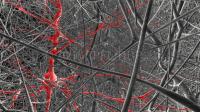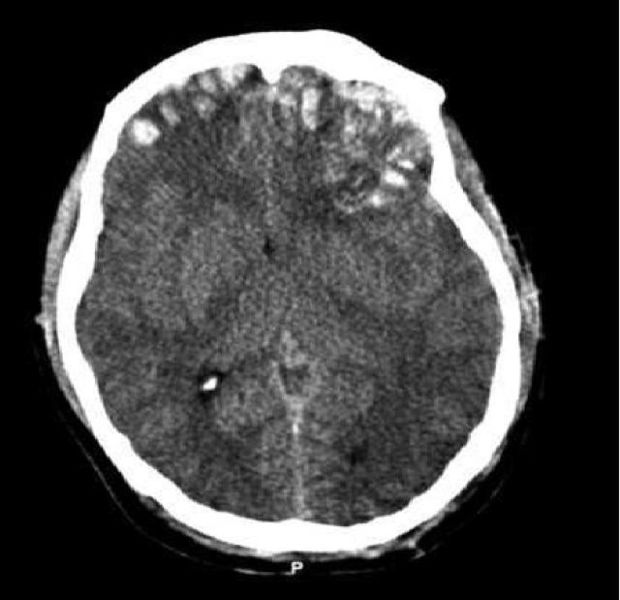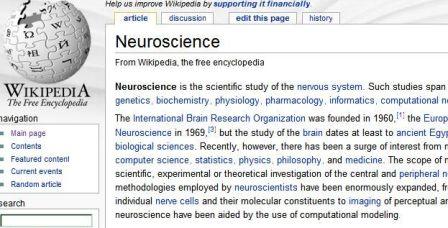Researcher says brain replica feasible in 10 years and other neurology news
 Layer four neuron in context. Image courtesy Blue Brain Project, Ecole Polytechnique Federale de Lausanne
Layer four neuron in context. Image courtesy Blue Brain Project, Ecole Polytechnique Federale de Lausanne
This scan includes briefs on development of a replica of a human brain, athletes who donate their brains to scientific research on concussions, controversies surrounding end-of-life care, concerns about voluntary brain scans, and neuroscience on Wikipedia.
Professor and neuroscientist Henry Markram of the Brain Mind Institute in Switzerland believes scientists could have a brain model that replicates the functions of the human brain in 10 years. Markram’s team has assembled hundreds of thousands of small pieces of data that his lab has collected over the past 15 years.
Through its Blue Brain Project, the institute has built its first cellular-level model of the neocortical column. A parallel supercomputer performs experiments so that the behavior of the tissue can be predicted through simulations. “When we first switched it on it already started to display some interesting emergent properties,” stated Markram. “But this is just the beginning because we know now that it is possible to build it. As we progress we are learning about design secrets of our brains which were unimaginable before. In fact the brain uses some simple rules to solve highly complex problems and extracting each of these rules one by one is very exciting. For example we have been surprised at finding simple design principles that allow billions of neurons to connect to each other. I think we will understand how the brain is designed and works before we have finished building it.”
Video below: Zooming out, highlighting a single neuron
Blue Brain Project, Ecole Polytechnique Federale de Lausanne
Why is Markram confident?
“The brain is of course extremely complex because it has trillions of synapses, billions of neurons, millions of proteins, and thousands of genes. But they are still finite in number. Today's technology is already highly sophisticated and it allows us to reverse engineer the brain rapidly.”
The main barrier to completing the replica brain is money, according to Markram. “I absolutely believe it is technically and biologically possible. The only uncertainty is financial. It is an extremely expensive project and not all is yet secured.”
Markram envisions a brain model that will help researchers better understand brain diseases caused by faulty processing in brain circuits, neurons or synapses. Other benefits are outlined on the Blue Brain website.
Athletes donate brains to research
Three active NFL player have recently joined 150 retired athletes in donating their brains for concussion research via the Center for the Study of Traumatic Encephalopathy (CSTE).
Boston University School of Medicine, in collaboration with the Sports Legacy Institute (SLI), created the CSTE last year to conduct research of chronic traumatic encephalopathy. CTE is a progressive degenerative disease of the brain found in athletes and others with a history of repetitive concussions.
As part of the donor program, the athletes will also submit to annual interviews so researchers can examine the relationship between clinical symptoms and pathology.
Sports related head trauma is implicated in the death of numerous athletes who, following years of repeated concussions, developed CTE. Boxers, wrestlers, and football players are among those known to have died from CTE complications.

Image: CT scan of patient with brain trauma depicting multiple frontal, parietal, and temporal lobe contusions with associated interhemispheric hemorrhage and a left-sided subdural hematoma measuring 1.7 mm in greatest depth./Rehlman, Wikipedia
New ethical and legal challenges surrounding end-of-life counseling and euthanasia explored
The Lancet Neurology features an in-depth feature by Kathlyn Stone exploring some emerging controversies surrounding euthanasia, physician-assisted suicide, palliative care and the debate over so-called "death panels" in its October issue. Discussion of euthanasia and other end-of-life issues are currently dominated by the advanced directives components of the the United State's leading health reform plans, but it is a broader subject that will continue to resurface globally.
Researchers worry about growing market for voluntary brain screening tests
Commercially available brain scans are growing in popularity among healthy people who want to allay fears about undiagnosed brain cancer and stroke, but the unnecessary scans may do more harm than good, according to Rustam Al-Shahi Salman, a clinician scientist at the University of Edinburgh. "The difficulty with these health check-ups is that in the small number of people who do harbour some undiagnosed brain condition, there is not a clear next step,” stated Salman.
In a study published in the British Medical Journal, researchers analyzed results of nearly 20,000 brain scans from people who undertook the tests for a variety of reasons, such as general health check-ups or volunteering for medical research. None of them had any symptoms suggesting that they had an underlying brain condition.
The researchers found that almost 3 percent of healthy people had an abnormality on a brain MRI scan and warn that even when an incidental abnormality -- such as a weakened blood vessel in the brain or a benign tumor -- is discovered, there is no clear medical evidence that treatment would do more good than harm.
"We do not have enough medical evidence to know whether we should treat the abnormalities or just leave them be. Until we have that knowledge, we cannot be sure that commercial screening benefits people with incidental findings on their brain scan. Furthermore, there is little evidence that "peace of mind" lasts for the people with normal brain scans."
Society for Neuroscience wants experts taking the lead on Wikipedia entries
Wikipedia, a free online encyclopedia, is a widely popular source of public information. After reviewing the neuroscience entries the Society for Neuroscience (SFN) diplomatically called them “under construction and incomplete.”

The SfN is calling upon its members to improve and expand Wikipedia's neuroscience content through editing and contributions. It will offer a "Writing for an audience of millions: Wikipedia and neuroscience" training session at its upcoming Neuroscience 2009 conference in Chicago, Ill., Oct. 17-21.
The Neuro Revolution
Michael F. Huerta, Ph.D. reviews The Neuro Revolution, a new book exploring the intersection of neuroscience and neurotechnology by Zack Lynch, founder and executive director of the Neurotechnology Industry Organization.



 del.icio.us
del.icio.us Digg
Digg












I would however like to offer my - admittedly less informed than his is - opinion concerning Professor Markram's remark that;
"The main barrier to completing the replica brain is money..."
It could well be that all the money in the world could not unravel all of the issues concerning the brain given current technology and techniques, and that we are a still a very long way from having that capacity.....
Great read, thanks.
.In healthy brain tissue, virtually no protein tangles, which show up as brown spots, are visible....
Post your comment